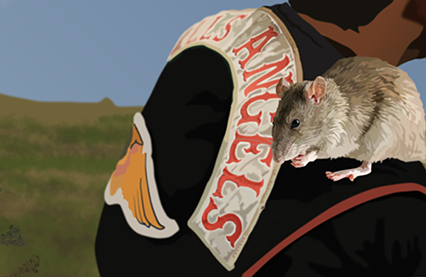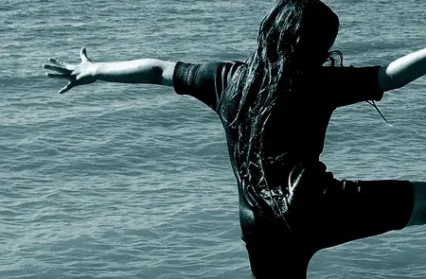Events at a meeting of the Welsh Academy of Psychiatry, November 13, 2012.
I am pretty certain that all of you sitting here today will have heard of writer’s block, defined by one of my colleagues as an inability to begin or continue writing for reasons other than lack of basic skill or commitment.
Samuel Taylor Coleridge, F Scott Fitzgerald and JK Rowling are among many authors who have succumbed to this debilitating condition at one time or another.
But I want to discuss another type of ‘block’. I want to tell you about an emotional barrier, which may have far-reaching consequences for the psychiatrist and his patient. The condition is little known in the world outside our profession, and is seldom discussed in academic papers or journals. I will describe it simply as psychiatrist’s block. The over-used phrase ‘elephant in the room’ is especially relevant in this case. I must admit that it has taken me considerable personal bravery to stand before you today, to discuss phobias in general, but if I can help just one person then my actions will have been worthwhile.
First, I would like to deal with some historical case studies involving psychiatry and animals, in keeping with the title of my talk.
Where better to start than with Freud’s Rat Man, a patient suffering from an obsessive compulsive disorder. One of his symptoms involved a fantasy in which both his fiancée and his father were gnawed alive by rats contained in a pot tied to their buttocks.
The patient, a highly intelligent lawyer, was cured of his obsession but, with the pathos and irony typical of our profession, he was killed as soon as he felt better – in the Great War.
The vast majority of psychiatrists have never had to deal with such a fascinating case. Their lives would have been far more interesting if they had. Are modern people more boring, or were previous generations more neurotic? And what could have possibly caused the patient’s obsession with rats and buttocks? Freud had all the answers, as usual. Punishment for childhood masturbation, disguised homosexual fantasies – yes, Vienna was the place to be all those years ago, at the dawn of psychiatry. Sadly, all the Rat Men were spirited away by the Pied Piper of mental health many years ago.
At this point I would like to mention another example of animals roaming around the field of psychiatry.
Take Alice, that sweet little girl who went a-wandering in Wonderland, and who gave the dormouse such a hard time. Yes, that innocent little girl who felt obliged to mention her cat Dinah over and over again, as if wishing to torture the poor mouse. Whose neurosis was in question? Did the real life Alice fear mice, and if so, was she getting her revenge on the written page? Or was Lewis Carroll having a swipe at Alice’s governess, the shrewish Miss Pritchett, who could be seen as his rival? Herr Doctor Freud, where are you when we need you?
And since we’re living in an age of wall-to-wall celebrities, most of them barking mad, let’s study some famous people, people with fear etched all over their faces.
Michael Jackson was scared stiff of dogs.
Adolf Hitler was terrified of cats. So was Genghis Khan, so was Benito Mussolini, and so was Napoleon Bonaparte. Scared of cats? You’re cut out to be a mad, despotic tyrant.
Now here’s the biggy. Walt Disney, yes Walt Disney, a man made famous by a mouse, was scared of…er…mice.
So those of you with unreasonable fears and deep-seated phobias, take heart. You’re in good – and very bad – company.
But that’s enough frivolity. Let’s get back to brass tacks, because I want to tell you about three cases in which people have been treated successfully for a deep fear of mice. Incidentally, I’d like to remind you that a group of mice is called a mischief.
Patient A was a Hell’s Angel from the notorious Welsh chapter, the Blue Pistons. He conformed to all the stereotypes associated with the Hell’s Angels movement: he was large, hairy, violent and smelly. Treating him was like going for a walk with the Incredible Hulk down a dark alleyway in the tenth week of a binmen’s strike. I was obliged to open all the windows before he arrived for his weekly treatment, and I also took the precaution of having a panic button installed. One cannot be too careful, though in the eventuality he turned out to be as tame as a hamster. This is the testimony of Patient A, as I recorded it on a digital voice recorder.
Me and the boys decided to go for a ride one Easter. Bit of a laugh, holiday like. So we hit the road without a map as per usual and ended up in the Lake District. Pure chance, but I’d always wanted to go there, me mum used to read me them Peter Rabbit stories, god bless her. Eventually we found a campsite prepared to take us and we only just managed to get the tents up before dark. It was very cold that night but we had plenty of booze so it didn’t matter much. We had a good session and I woke up early because of the cold, went outside and the ground was white. Lovely to look at, but an old biker like me gets worried about his machine so I kicked her over just in case.
Woke them up I did, so being a gent I boiled some water and made the lads in my tent a brew. We’d left a bottle of milk leaning against a fence post but when I tried to pour some into the mugs nothing came out. I thought the milk had frozen so I pokes me finger in to get some action. You won’t believe what’d happened, a little mousy had climbed in there when we was sleepin’ and it’d only gone and drowned, poor mite. His little face reminded me of an Angel from Somerset we tossed in a river at one of them festivals and played about with for a bit, pushed him down with some paddles. Nearly drowned the poor bugger, pardon my French guv. Anyway, I couldn’t get any milk out while mousy was acting as a stopper so I pushed him down with a twig so the milk could get out. Didn’t seem to make any difference to the tea, the boys didn’t notice. I told them afterwards and they thought it was a laugh. In fact it seemed to get mentioned every Easter after that, death by milk instead of death by crucifixion, and one of the girls always gave me a white chocolate mouse with a little red ribbon round its neck, in fact that’s how me and Maggie got together in the first place. She moved in with me the third Easter after it happened. Got me red wings now guv but you wouldn’t want to know how a man gets his red wings.
So there we have the testimony of Patient A. However, it wasn’t the campsite incident which kicked off his mouse phobia. Nothing so simple, unfortunately. No, his musophobia had started quite suddenly when his girl, Maggie, ran off with another biker a few years later. Poor Patient A was so traumatized – actually, he was a bit of a wuss – he’d developed a nervous reaction to chocolate mice whenever he saw one in a shop. And what started as a chocolate mouse aversion developed into a full scale fear of the real thing. He intimated at one point that a huge mouse with a red scarf around its neck had appeared to him during a bad acid trip, and maybe that had done some unpleasant things to his mind, already somewhat unbalanced.
I decided to play it safe with Patient A, for obvious reasons. You don’t want a seven-foot gorilla having a psychotic incident in your treatment room.
He started a conventional course of treatment, involving desensitization, in which a cage containing a live mouse was moved towards him slowly across the room over many months. All seemed to be going well; he had been ready to hold the mouse in his hand at our final meeting just before Easter 2001, when sadly fate intervened and he met a violent death in a feud involving shotguns and a lot of blood somewhere in the woods above Colwyn Heights. By all accounts he suffered a painful end. I am told that a slate mouse has been carved on his gravestone, and that every Easter a little red ribbon is tied around its neck. Being a sentimental soul I like to think that Maggie goes there every year to pay her respects. May his soul rest in peace.
Patient B, who came to me in the winter of 1995, was a presentable young man who had entered university as an arts student. After the customary year in a hall of residence he had teamed up with a fellow student and they had rented a house on a hill above the old slate-quarrying town of Bethesda in North Wales. I believe he was taking a joint honours degree in Welsh and English, though he seemed to spend most of his time studying the local barmaids. Seldom did he arrive at my room in the Students’ Union building without an accompanying waft of alcohol.
This is the story of Patient B, in his own word, as I wrote it down in my diary. I quote:
It was bedtime in Bethesda on a stormy night in December. I must have been doing some college work for a change, because I was relatively clean and sober. I had sat with my housemate, Jim, also a student, in front of a big fire being drawn up through the chimney in noisy gasps. A great storm was raging down the Ogwen Valley and we were enjoying its screams and tantrums, since we were snug and cosy. Jim offered to make us a mug of hot chocolate and we spent a pleasant hour listening to nature and marveling at its power.
Just then a couple of tiny black mice appeared from nowhere and started to play around our feet. We had never seen them before, indeed we had no idea that we were sharing our little cottage with them, so we sat stock still while they scuttled around our feet. I was not scared of mice at that stage, and I remained totally unphased. We were intrigued and amused by the mice’s antics. They almost danced at times, or scuttled here and there in quick darts. We could see their whiskers quivering and their tails snaking from side to side. Throughout this little circus display they remained completely unaware of our presence. So we sat in our worn old armchairs, in front of a hot fire, listening to the wind in the chimney and watching our miniature performers.
And then something extraordinary happened. One of the mice crept up my left ankle, and after nosing around it worked its way into my sock and seemingly went to sleep there. In no time at all the other had followed it and had also gone to sleep. I lifted my trouser leg and saw two little bubbles playing doggo, or should that be mouso, inside my regulation black stocking. Jim and I exchanged glances and grinned. The mice had been a surprise, but this feat of theirs truly astonished us. I felt like David Attenborough somewhere in the jungle, in the company of a really rare species. But since it was well past bedtime I had to do something, so I gently dislodged the mice from their temporary hammock by pulling away the top of my sock, and they rolled down to the floor, looking like two little kids playing rolly-polly in the snow. We went to our beds, and did no more about it, though we had a chat the following day as to whether or not we should buy a mousetrap. We decided to leave things as they were, and to act only if the mice became a pest. In the event we never saw them again. Perhaps they were storm mice, appearing only once in a while, when the valley was experiencing a tempest. Indeed, I remember writing a short story in which our two little rodents, dormant over long periods of history, became active only when the wind whistled at a particular pitch on the rocky panpipes of the Black Ladders.
And so ends the rather fanciful account of Patient B. Again, it was a secondary issue which had created a fear of mice in this patient. It seems that he was a bit of a climber, and one day, not so long after the storm mice appeared, he was up on the Black Ladders – a notorious accident spot in the Carneddau range nearby – when he experienced a frightening vision. He was leading a two-man climb up a severe pitch when he attempted a particularly difficult jughold above him to the left. As his fingers fumbled for the hold he had the distinct sensation of feeling fur or whiskers brushing against his hand. Looking up, he saw a huge mouse peering down at him, its dark eyes gleaming with malice. He let out a scream and nearly lost his grip on the rock. Fortunately he was able to knock in a belay and descend to the ledge where his companion was waiting for him, full of anxiety. Patient B was too embarrassed to tell the truth and he invented an excuse, but he refused to go on and they abandoned the climb. Subsequently he developed a superstitious aversion to all rodents, black storm mice in particular.
Again, I utilised a desensitizing technique, though slightly different in his case, since Patient B had a well developed sense of humour and I felt that his condition could be alleviated with levity. So I asked my mother, a keen knitter, to create two black mice for him. She had a Kafkaesque disposition, which suited the occasion, and she produced two absurd, cartoonish mice, each with eight legs like a spider and other surreal attributes. These were hung in a woollen cobweb in the corner of the room where the storm mice had appeared, and I encouraged Patient B to approach his new friends, getting closer and closer every day. This worked wonderfully. Patient B overcame his fear and went on to become a legendary climber. It was he who first conquered the appropriately named Mouse of Horror pitch on Cemetery Gates in the Ogwen Valley. Indeed, he and his equally famous climbing partner are still known as Gorgon and Zola.
Patient C was completely different. She was a bright young girl of seven, almost precocious, who lived with her teacher parents in a lovely house in its own secluded grounds on the outskirts of Colwyn Bay.
Our patient had been texting one of her friends in her bedroom one evening when her eye was caught by a sudden movement in the corner of the room. On looking up she saw a mouse, which executed a little dance and then washed its face with its paws before disappearing beneath her computer table.
This girl had been only slightly disturbed and had tried to use her intelligence to calm herself, making jokes about her computer mouse, etc. What does a mouse do in the daytime? she asked me at our first meeting, and when I said I didn’t know, she laughed and said mousework.
But she was sleeping badly and her schoolwork was suffering. So I hit on a plan.
I advised Alice’s parents to buy a humane rodent catcher, the sort which traps the animal without killing it. Next, I approached a homeless man who could be seen daily in the centre of town, playing a tin whistle rather badly, and made him a proposition. In return for a small sum of money he agreed to play along with my ruse.
When, eventually, the mouse was caught in our plastic trap the parents called me as arranged. When I went to the house all three of them were standing in the driveway, waiting. With the mouse between us on a garden table, I outlined my plan. I said:
Alice, this mouse deserves to live. It has its own life, its own part to play in the cosmic story. So I propose that we let it go. But obviously we wouldn’t want to let it free in the house, or the garden, since it would probably head straight back to the warmth and comfort of your snug little bedroom. So this is what I think we should do. Together, we’ll head for a nice little park on the other side of town and release it into the wild, somewhere nice where your mousy can make a new life for itself.
Naturally, this plan went down a storm, so while the family went to get togged up I made a quick call to the homeless man, whom I’d hand picked for the job, since he looked positively medieval in his hooded jacket, floppy woolen hat and baggy trousers.
He was as good as his word, and when we arrived at the park Alice spotted him immediately, standing under a tree, playing his tin whistle as eerily as ever.
‘The Pied Piper!’ she said excitedly, and it was all we could do to stop her from rushing over to him.
While the piper played under his tree I took the trap to a shrubbery and released the captive mouse. It hesitated for a few seconds then dashed into the undergrowth.
When I straightened up I put my hand on my head, as prearranged, and the pied piper moved away from us slowly, his plaintive tune receding into the distance. My plan had worked perfectly. As we stood there in silence with our empty trap, the parents turned to each other and beamed. Alice was delighted and wrote a first novel about the experience when she was only ten. She is now one of the country’s foremost nature writers and has won more awards than there are mice in your local branch of Computer World.
And so to the conclusion.
There is a folk belief that elephants are afraid of mice. Pliny the Elder recorded this enigma almost two thousand years ago. The TV programme Mythbusters conducted an experiment, which showed an elephant apparently attempting to avoid a mouse, so there may be some basis for this belief. And I am about to admit to you that I am the elephant in this room today.
Let me remind you that symptoms of a phobia such as musophobia can include extreme anxiety, shortness of breath, an irregular heartbeat, sweating, nausea, dry mouth and shaking. And I have little doubt that one member of the audience, sitting below me in the front row, is suffering some or all of these symptoms.
During my address I have looked down to see if I could detect any doubt or creeping uncertainty among you. I scanned your keen and attentive faces to see if anyone had begun to question the nature and substance of my lecture. But I am happy to say that all of you bar one appear to have received my message without quaking, or hurling insults at me, or rotten tomatoes (laughter).
But you have been badly misled, since I am not the person you think I am. The professional you expected to hear, and had every right to hear, was not in fact invited to this meeting. Instead, I have appeared in his place, at the invitation of one of your members, Professor William Morton LRCP, MRCS, MRCPsych (retired). As you well know, he’s the clean-shaven gentleman with a red bow tie in the back row, near the exit. You will also know that he has been unable to practice for over twenty years, since he suffers from agateophobia, which is a fear of madness or of going mad. And that is the psychiatric equivalent, in my books, of writer’s block.
And now the time has come for me to confess all and to tell you the naked truth.
I was Professor Morton’s penultimate patient. I was referred to him as part of my rehabilitation in the community following a seven-year jail sentence for fraud and embezzlement. To put it simply, for well over half my life I was a con man preying on rich, vulnerable people. You may have heard of me, since I have made regular appearances on Crimewatch. My name is Andrew ‘The Viscount’ Moroni, though I am also known as The Great Imposter. You may remember my biggest sting – selling famous London landmarks to gullible American entrepreneurs.
In his autobiography the famous con artist Joseph ‘Yellow Kid’ Weil, who stole over eight million dollars, said: “The desire to get something for nothing has been very costly to many people who have dealt with me and with other con men. The average person, in my estimation, is ninety-nine per cent animal and one per cent human. The ninety-nine per cent that is animal causes very little trouble. But the one per cent that is human causes all our woes.”
Ladies and gentlemen, I said earlier that none of you showed any signs of having a phobia during my speech. And that was almost true, but there was in fact one person who began to show signs of fear whenever I left the lectern and moved to the front of the dais. People sitting next to her may have noticed that she showed signs of deep distress; she shrank back in her chair, and at one stage held her hands over her eyes. I won’t identify her, since that would be indelicate. Suffice it to say that today she is facing her final test in a long programme of treatment for a rare and difficult phobia.
And what is that phobia, you might ask. The clue, ladies and gentlemen, is in my noble visage. During the course of the last hour you may have observed that I possess a full and bushy beard. Indeed, I could pass for one of the Pilgrim Fathers. But in keeping with my career as a con man, my beard is in fact bogus. It was glued in place earlier this afternoon by Professor Morton himself, and let me tell you that many guffaws and giggles passed between us as we went about our business. The result, as you can see, is most convincing. But what has that to do with the woman who has spent the last hour cringing and shaking in the front row?
The answer is simple. The woman in question suffers from pogonophobia, or a fear of beards. And today she is being put to the test. The final test. Because if she can live through this ordeal she will have finally conquered her phobia. And wouldn’t that be marvelous. Wouldn’t that be simply wonderful. Oh dear, can someone grab her? Quick! Stop her falling! Professor Morton….
This meeting was abandoned, and paramedics attended after a call from the secretary. Tea and biscuits were served. Mrs Harris proposed the vote of thanks. The next meeting will be on March 9, 2013, guest speaker to be announced.
A vacancy exists following Professor Morton’s resignation. Please contact me if you know of anyone suitable.
Davina Froust, Secretary.
Banner Illustration by Dean Lewis













